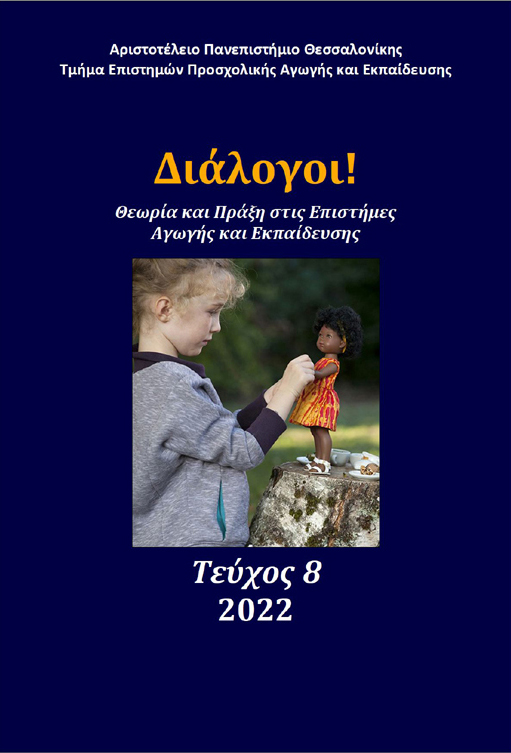Παραστασιακό άγχος και πάγωμα επί σκηνής: Ψυχομετρική αξιολόγηση και διαγνωστική επικύρωση κλείδας παρατήρησης παιδιών στην προεφηβεία για τον εκπαιδευτικό

Περίληψη
Η σχολική θεατρική παράσταση αποτελεί μία κορυφαία στιγμή δημιουργικής έκφρασης επιτελώντας πολλαπλές εκπαιδευτικές λειτουργίες και καλλιτεχνικούς σκοπούς. Ωστόσο, όσοι λαμβάνουν μέρος ως ηθοποιοί έρχονται αντιμέτωποι με πολλές δυσκολίες που πρέπει να ξεπεράσουν προκειμένου να υποστηρίξουν τον ρόλο τους, γεγονός το οποίο αποτελεί πηγή άγχους για τους ίδιους. Ορισμένα άτομα αισθάνονται άβολα στη σκηνή λόγω του άγχους που τους δημιουργείται από την κοινωνική τους έκθεση με αποτέλεσμα να δυσχεραίνεται η παιδαγωγική λειτουργία της παράστασης. Αν και είναι γενικά αποδεκτό ότι το άγχος αυτό μπορεί να λειτουργήσει θετικά, όταν υπάρχει σε τέτοιο βαθμό ώστε να κινητοποιεί το άτομο να λειτουργεί αποτελεσματικά, υποστηρίζεται ότι η έκθεση σε υπερβολικά αγχογόνες καταστάσεις δύναται να επιφέρει αρνητικές συνέπειες. Στο πλαίσιο αυτό η εποπτεία των επιπέδων του άγχους επί σκηνής κρίνεται επιτακτική. Σκοπός της εργασίας είναι η παρουσίαση ενός εργαλείου καταγραφής και αξιολόγησης των επιπέδων του παραστασιακού άγχους προεφήβων μαθητών, όταν οι τελευταίοι λαμβάνουν μέρος σε μία θεατρική παράσταση. Για την επίτευξη του σκοπού αξιοποιήθηκαν δεδομένα παρατήρησης από 792 μαθητές που έπαιζαν ρόλους σε σχολικές θεατρικές παραστάσεις. Σύμφωνα με τα αποτελέσματα της μελέτης δημιουργήθηκε μέσω ψυχομετρικών μεθόδων μία σύντομη, αξιόπιστη και έγκυρη κλείδα παρατήρησης για τον εκπαιδευτικό και μέσω μεθευρετικών τεχνικών υπολογιστικής νοημοσύνης ένας διαγνωστικός μηχανισμός εντοπισμού επικίνδυνων επιπέδων παραστασιακού άγχους, παρέχοντας παράλληλα στοιχεία επιπολασμού για το φαινόμενο του παγώματος επί της σκηνής σε πληθυσμούς προεφήβων.
Λεπτομέρειες άρθρου
- Πώς να δημιουργήσετε Αναφορές
-
Μαστροθανάσης Κ., & Κλαδάκη Μ. (2022). Παραστασιακό άγχος και πάγωμα επί σκηνής: Ψυχομετρική αξιολόγηση και διαγνωστική επικύρωση κλείδας παρατήρησης παιδιών στην προεφηβεία για τον εκπαιδευτικό. Διάλογοι! Θεωρία και πράξη στις επιστήμες αγωγής και εκπαίδευσης, 8, 40–69. https://doi.org/10.12681/dial.27921 (Original work published 18 Φεβρουάριος 2022)
- Τεύχος
- Τόμ. 8 (2022)
- Ενότητα
- Επιστημονική Αρθογραφία

Αυτή η εργασία είναι αδειοδοτημένη υπό το CC Αναφορά Δημιουργού – Μη Εμπορική Χρήση – Παρόμοια Διανομή 4.0.
Οι συγγραφείς των άρθρων που δημοσιεύονται στο Διάλογοι! Θεωρία και Πράξη στις Επιστήμες Αγωγής και Εκπαίδευσης διατηρούν τα δικαιώματα πνευματικής ιδιοκτησίας επί των άρθρων τους, δίνοντας στο περιοδικό το δικαίωμα της πρώτης δημοσίευσης. Άρθρα που δημοσιεύονται στο Διάλογοι! Θεωρία και Πράξη στις Επιστήμες της Αγωγής και Εκπαίδευσης διατίθενται με άδεια Creative Commons 4.0 και σύμφωνα με την άδεια μπορούν να χρησιμοποιούνται ελεύθερα, με αναφορά στον/στη συγγραφέα και στην πρώτη δημοσίευση για μη κερδοσκοπικούς σκοπούς και με δικαίωμα τροποποίησης μόνον με παρόμοια διανομή (αν αναμείξετε, τροποποιήσετε, ή δημιουργήσετε πάνω στο υλικό, πρέπει να διανείμετε τις δικές σας συνεισφορές υπό την ίδια άδεια όπως και το πρωτότυπο).
To Τμήμα Επιστημών Προσχολικής Αγωγής και Εκπαίδευσης του Αριστοτέλειου Πανεπιστημίου Θεσσαλονίκης και το Εθνικό Κέντρο Τεκμηρίωσης διατηρούν το δικαίωμα να δημοσιεύουν, να αναπαραγάγουν, να παρουσιάζουν στο κοινό, να διανέμουν και να χρησιμοποιούν άρθρα που δημοσιεύονται στο Διάλογοι! Θεωρία και Πράξη στις Επιστήμες Αγωγής και Εκπαίδευσης σε οποιοδήποτε μέσο και μορφή είτε μεμονωμένα είτε ως μέρη συλλογικών έργων, για όλο το χρόνο διάρκειας προστασίας της πνευματικής ιδιοκτησίας και για όλες τις χώρες του κόσμου.
Αυτό περιλαμβάνει ενδεικτικά, και όχι αποκλειστικά, το δικαίωμα δημοσίευσης των άρθρων σε τεύχη του περιοδικού Διάλογοι! Θεωρία και Πράξη στις Επιστήμες Αγωγής και Εκπαίδευσης, αναπαραγωγής και διανομής μεμονωμένων αντιγράφων των άρθρων, αναπαραγωγής ολόκληρων των άρθρων σε άλλη έκδοση του Τμήματος Επιστημών Προσχολικής Αγωγής και Εκπαίδευσης του Αριστοτέλειου Πανεπιστημίου Θεσσαλονίκης και του Εθνικού Κέντρου Τεκμηρίωσης και αναπαραγωγής και διανομής των άρθρων ή περίληψης αυτών με χρήση πληροφορικού συστήματος αποθετηρίου.


